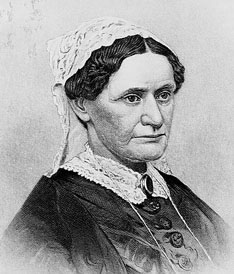Eliza Johnson First Spouse Gold Coins
The Eliza Johnson First Spouse Gold Coins honor the wife of the seventeenth President of the United States. The coin, however, is the eighteenth to be struck in the series and the first of four to be issued in 2011.
 Authorized by the Presidential $1 Coin Act of 2005, each strike features a $10 face value and is struck from 1/2 ounce of 24-karat gold to either proof or uncirculated condition. The US Mint will also produce bronze medal reproductions of the Eliza Johnson First Spouse Gold Coins.
Authorized by the Presidential $1 Coin Act of 2005, each strike features a $10 face value and is struck from 1/2 ounce of 24-karat gold to either proof or uncirculated condition. The US Mint will also produce bronze medal reproductions of the Eliza Johnson First Spouse Gold Coins.
The obverse (heads side) of each strike contains a portrait of the former first lady. The reverse (tails side) shows a scene from Eliza’s life. The final designs were announced in early February and the 2011 release date has been scheduled for May 5.
Eliza Johnson Biography (1810-1876)

Eliza was born the daughter of John and Sarah McCardle on October 4, 1810. Her father, who was a shoemaker, passed away while she was still very young forcing her mother to raise her on her own. Still, Eliza received an adequate education which she would one day use to help educate her husband.
She first met Andrew Johnson in her home-town of Greeneville, Tennessee. He had recently moved there from North Carolina to find work as a tailor. They immediately took a liking to each-other and were married on May 17, 1827. Eliza was only sixteen years old with Andrew three years her senior.
Eliza immediately went about the work of setting up and maintaining her household – a tradition which she would maintain through the rest of her life, regardless of the political positions her husband would attain. It is thought, though, that Eliza did much to support her husband personally, even though she did not publicly push his political ambitions.
She is credited by many with helping to further educate Andrew who only had basic reading and writing skills when they met. She also persuaded him to join a debating group which would hone skills that would eventually be called into play in the political world.
Still building his tailoring business, Andrew was first elected alderman, then mayor of Greeneville. A few years later, he was elected to the Tennessee House of Representatives and would continue his political career in several offices leading to the Governor of Tennessee in 1853. When the idea of secession from the Union passed in Tennessee, Andrew was a United States Senator who, like most of those in eastern Tennessee, supported the Union.
That position propelled Andrew further up the political ladder to the point where he was elected Vice-President under Abraham Lincoln in 1864. When Lincoln was assassinated a month later, Andrew assumed the Presidency.
Throughout all of the offices Andrew held, Eliza maintained her home back in Tennessee and raised the children. Only when Andrew became President did Eliza move to Washington. Still, she preferred the job of mother and wife to that of First Lady and left all of the ceremonial duties to her very capable daughter, Martha Johnson Patterson.
After leaving the White House, the Johnson’s returned to Tennessee where Andrew fluttered in and out of the political spectrum. He passed away in 1875 shortly after being elected once again to the United States Senate. Eliza, who was in frail health for a large portion of her life, passed away six months later.